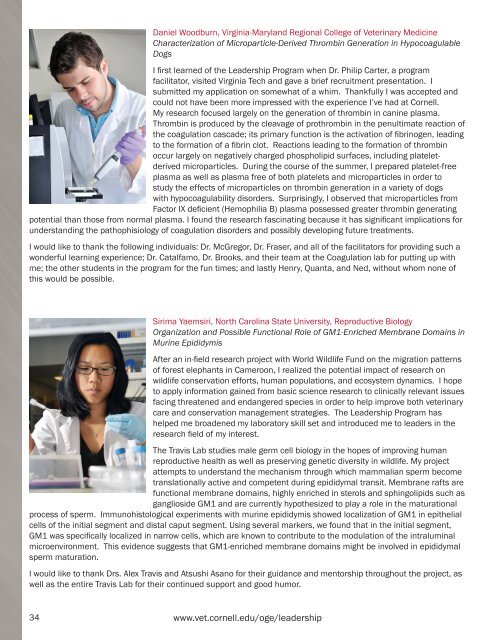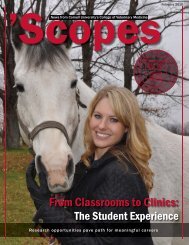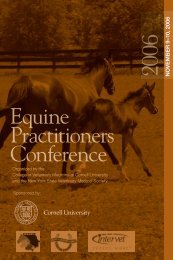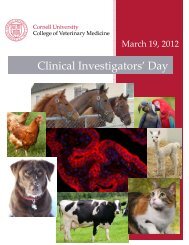2010 (PDF) - The College of Veterinary Medicine at Cornell University
2010 (PDF) - The College of Veterinary Medicine at Cornell University
2010 (PDF) - The College of Veterinary Medicine at Cornell University
You also want an ePaper? Increase the reach of your titles
YUMPU automatically turns print PDFs into web optimized ePapers that Google loves.
Daniel Woodburn, Virginia-Maryland Regional <strong>College</strong> <strong>of</strong> <strong>Veterinary</strong> <strong>Medicine</strong><br />
Characteriz<strong>at</strong>ion <strong>of</strong> Microparticle-Derived Thrombin Gener<strong>at</strong>ion in Hypocoagulable<br />
Dogs<br />
I fi rst learned <strong>of</strong> the Leadership Program when Dr. Philip Carter, a program<br />
facilit<strong>at</strong>or, visited Virginia Tech and gave a brief recruitment present<strong>at</strong>ion. I<br />
submitted my applic<strong>at</strong>ion on somewh<strong>at</strong> <strong>of</strong> a whim. Thankfully I was accepted and<br />
could not have been more impressed with the experience I’ve had <strong>at</strong> <strong>Cornell</strong>.<br />
My research focused largely on the gener<strong>at</strong>ion <strong>of</strong> thrombin in canine plasma.<br />
Thrombin is produced by the cleavage <strong>of</strong> prothrombin in the penultim<strong>at</strong>e reaction <strong>of</strong><br />
the coagul<strong>at</strong>ion cascade; its primary function is the activ<strong>at</strong>ion <strong>of</strong> fi brinogen, leading<br />
to the form<strong>at</strong>ion <strong>of</strong> a fi brin clot. Reactions leading to the form<strong>at</strong>ion <strong>of</strong> thrombin<br />
occur largely on neg<strong>at</strong>ively charged phospholipid surfaces, including pl<strong>at</strong>eletderived<br />
microparticles. During the course <strong>of</strong> the summer, I prepared pl<strong>at</strong>elet-free<br />
plasma as well as plasma free <strong>of</strong> both pl<strong>at</strong>elets and microparticles in order to<br />
study the effects <strong>of</strong> microparticles on thrombin gener<strong>at</strong>ion in a variety <strong>of</strong> dogs<br />
with hypocoagulability disorders. Surprisingly, I observed th<strong>at</strong> microparticles from<br />
Factor IX defi cient (Hemophilia B) plasma possessed gre<strong>at</strong>er thrombin gener<strong>at</strong>ing<br />
potential than those from normal plasma. I found the research fascin<strong>at</strong>ing because it has signifi cant implic<strong>at</strong>ions for<br />
understanding the p<strong>at</strong>hophisiology <strong>of</strong> coagul<strong>at</strong>ion disorders and possibly developing future tre<strong>at</strong>ments.<br />
I would like to thank the following individuals: Dr. McGregor, Dr. Fraser, and all <strong>of</strong> the facilit<strong>at</strong>ors for providing such a<br />
wonderful learning experience; Dr. C<strong>at</strong>alfamo, Dr. Brooks, and their team <strong>at</strong> the Coagul<strong>at</strong>ion lab for putting up with<br />
me; the other students in the program for the fun times; and lastly Henry, Quanta, and Ned, without whom none <strong>of</strong><br />
this would be possible.<br />
Sirima Yaemsiri, North Carolina St<strong>at</strong>e <strong>University</strong>, Reproductive Biology<br />
Organiz<strong>at</strong>ion and Possible Functional Role <strong>of</strong> GM1-Enriched Membrane Domains in<br />
Murine Epididymis<br />
After an in-fi eld research project with World Wildlife Fund on the migr<strong>at</strong>ion p<strong>at</strong>terns<br />
<strong>of</strong> forest elephants in Cameroon, I realized the potential impact <strong>of</strong> research on<br />
wildlife conserv<strong>at</strong>ion efforts, human popul<strong>at</strong>ions, and ecosystem dynamics. I hope<br />
to apply inform<strong>at</strong>ion gained from basic science research to clinically relevant issues<br />
facing thre<strong>at</strong>ened and endangered species in order to help improve both veterinary<br />
care and conserv<strong>at</strong>ion management str<strong>at</strong>egies. <strong>The</strong> Leadership Program has<br />
helped me broadened my labor<strong>at</strong>ory skill set and introduced me to leaders in the<br />
research fi eld <strong>of</strong> my interest.<br />
<strong>The</strong> Travis Lab studies male germ cell biology in the hopes <strong>of</strong> improving human<br />
reproductive health as well as preserving genetic diversity in wildlife. My project<br />
<strong>at</strong>tempts to understand the mechanism through which mammalian sperm become<br />
transl<strong>at</strong>ionally active and competent during epididymal transit. Membrane rafts are<br />
functional membrane domains, highly enriched in sterols and sphingolipids such as<br />
ganglioside GM1 and are currently hypothesized to play a role in the m<strong>at</strong>ur<strong>at</strong>ional<br />
process <strong>of</strong> sperm. Immunohistological experiments with murine epididymis showed localiz<strong>at</strong>ion <strong>of</strong> GM1 in epithelial<br />
cells <strong>of</strong> the initial segment and distal caput segment. Using several markers, we found th<strong>at</strong> in the initial segment,<br />
GM1 was specifi cally localized in narrow cells, which are known to contribute to the modul<strong>at</strong>ion <strong>of</strong> the intraluminal<br />
microenvironment. This evidence suggests th<strong>at</strong> GM1-enriched membrane domains might be involved in epididymal<br />
sperm m<strong>at</strong>ur<strong>at</strong>ion.<br />
I would like to thank Drs. Alex Travis and Atsushi Asano for their guidance and mentorship throughout the project, as<br />
well as the entire Travis Lab for their continued support and good humor.<br />
34 www.vet.cornell.edu/oge/leadership








